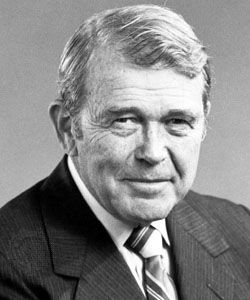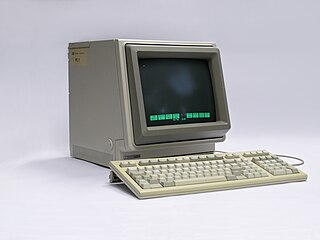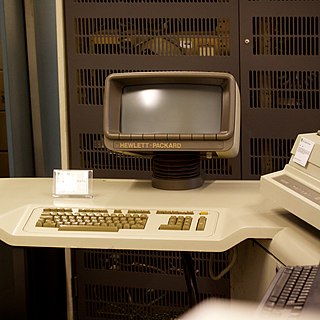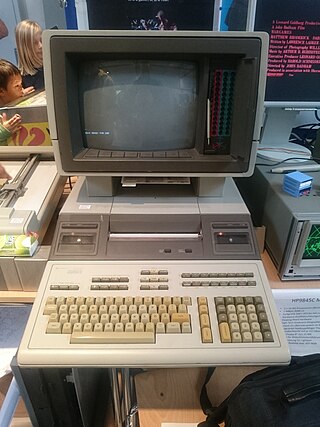
A plotter is a machine that produces vector graphics drawings. Plotters draw lines on paper using a pen, or in some applications, use a knife to cut a material like vinyl or leather. In the latter case, they are sometimes known as a cutting plotter.
Reverse Polish notation (RPN), also known as reverse Łukasiewicz notation, Polish postfix notation or simply postfix notation, is a mathematical notation in which operators follow their operands, in contrast to prefix or Polish notation (PN), in which operators precede their operands. The notation does not need any parentheses for as long as each operator has a fixed number of operands.

William Redington Hewlett was an American engineer and the co-founder, with David Packard, of the Hewlett-Packard Company (HP).

The Last Starfighter is a 1984 American space opera film directed by Nick Castle. The film tells the story of Alex Rogan, a teenager recruited by an alien defense force to fight in an interstellar war. It also features Robert Preston, Dan O'Herlihy, Catherine Mary Stewart, Norman Snow, and Kay E. Kuter.

NewWave is a discontinued object-oriented graphical desktop environment and office productivity tool for PCs running early versions of Microsoft Windows. It was developed by Hewlett-Packard and introduced commercially in 1988. It was used on the HP Vectras and other IBM compatible PCs running Windows.

Ralph Angus McQuarrie was an American conceptual designer who worked in film and television. His career included work on the original Star Wars trilogy, the original Battlestar Galactica television series, the film E.T. the Extra-Terrestrial, and the film Cocoon, for which he won an Academy Award.

HP-150 was a compact, powerful and innovative computer made by Hewlett-Packard in 1983. It was based on the Intel 8088 CPU and was one of the world's earliest commercialized touch screen computers. Like other "workalike" IBM PC clones of the time, despite running customized MS-DOS versions 2.01, 2.11 and 3.20, the machine was not IBM PC DOS compatible. Its 8088 CPU, rated at 8 MHz, was faster than the 4.77 MHz CPUs used by the IBM PC of that period. Using add-on cards, main memory could be increased from 256 KB to 640 KB. However, its mainboard did not have a slot for the optional Intel 8087 math coprocessor due to space constraints. An HP-150 with an optional hard disk was called HP Touchscreen MAX.

The HP 300 "Amigo" was a computer produced by Hewlett-Packard (HP) in the late 1970s based loosely on the stack-based HP 3000, but with virtual memory for both code and data. The HP300 was cut-short from being a commercial success despite the huge engineering effort, which included HP-developed and -manufactured silicon on sapphire (SOS) processor and I/O chips.

John Berkey was an American artist known for his space and science fiction themed works. Some of Berkey's best-known work includes much of the original poster art for the Star Wars trilogy, the poster for the 1976 remake of King Kong and also the "Old Elvis Stamp".

The Hewlett-Packard FOCUS microprocessor, launched in 1982, was the first commercial, single chip, fully 32-bit microprocessor available on the market. At this time, all 32-bit competitors used multi-chip bit-slice-CPU designs, while single-chip designs like the Motorola 68000 were a mix of 32 and 16-bit.
Voodoo Computers Inc. or VoodooPC was a luxury personal computer brand and company. Voodoo was originally started as a niche PC maker in Calgary, Alberta, Canada. It was founded in 1991, and acquired by Hewlett-Packard in 2006. Voodoo specialized in desktop high performance computing. By 2013 the Voodoo name was no longer used, and was replaced by the brand name Omen, which used the same logo until 2020.

HP Labs is the exploratory and advanced research group for HP Inc. HP Labs' headquarters is in Palo Alto, California and the group has research and development facilities in Bristol, UK. The development of programmable desktop calculators, inkjet printing, and 3D graphics are credited to HP Labs researchers.

The HP 250 was a multiuser business computer by Hewlett-Packard running HP 250 BASIC language as its OS with access to HP's IMAGE database management. It was produced by the General Systems Division (GSD), but was a major repackaging of desktop workstation HP 9835 from the HP 9800 series which had been sold in small business configurations. The HP 9835's processor was initially used in the first HP 250s.

The Hewlett-Packard Company, commonly shortened to Hewlett-Packard or HP, was an American multinational information technology company headquartered in Palo Alto, California. HP developed and provided a wide variety of hardware components, as well as software and related services to consumers, small and medium-sized businesses (SMBs), and large enterprises, including customers in the government, health, and education sectors. The company was founded in a one-car garage in Palo Alto by Bill Hewlett and David Packard in 1939, and initially produced a line of electronic test and measurement equipment. The HP Garage at 367 Addison Avenue is now designated an official California Historical Landmark, and is marked with a plaque calling it the "Birthplace of 'Silicon Valley'".
The Star Trek franchise features many spacecraft. Various space vessels make up the primary settings of the Star Trek television series, films, and expanded universe; others help advance the franchise's stories. Throughout the franchise's production, spacecraft have been depicted by numerous physical and computer-generated models. Producers worked to balance often tight budgets with the need to depict convincing, futuristic vessels.

The HP 9845C from Hewlett Packard was one of the first desktop computers to be equipped with a color display and light pen for design and illustration work. It was used to create the color war room graphics in the 1983 movie WarGames.

HP Inc. is an American multinational information technology company headquartered in Palo Alto, California, that develops personal computers (PCs), printers and related supplies, as well as 3D printing services. It was formed on November 1, 2015, as the legal successor of the original Hewlett-Packard after the company's enterprise product and business services divisions were spun off as a new publicly traded company, Hewlett Packard Enterprise.

Star Science Fiction Stories No.4 is the fourth book in the anthology series, Star Science Fiction Stories, edited by Frederik Pohl. It was first published in 1958 by Ballantine Books, and was reprinted in 1972. These books have been very critically acclaimed by critics around the world.
The Empire Strikes Back is a 1980 American epic space opera film directed by Irvin Kershner, with a screenplay by Leigh Brackett and Lawrence Kasdan, based on a story by George Lucas. It is the sequel to Star Wars (1977), the second film in the Star Wars film series, and the fifth chronological chapter of the Skywalker Saga. Set three years after the events of Star Wars, its story follows the battle between the Galactic Empire led by Emperor Palpatine and the Rebel Alliance led by Princess Leia. Meanwhile, Luke Skywalker trains to master the Force so he can confront the Sith lord Darth Vader. The ensemble cast includes Mark Hamill, Harrison Ford, Carrie Fisher, Billy Dee Williams, Anthony Daniels, David Prowse, Kenny Baker, Peter Mayhew, and Frank Oz.













